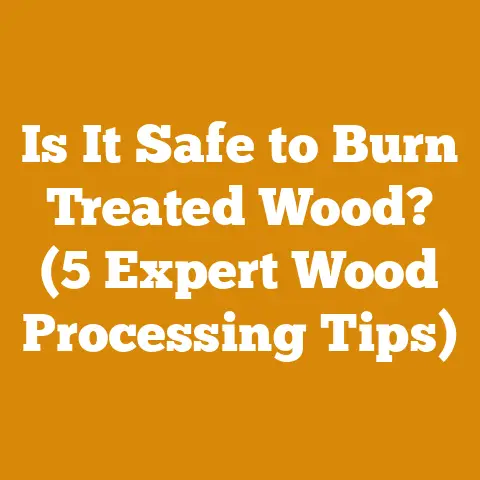Wood Burning Stove Temperature (5 Pro Tips to Reduce Creosote)
It was a blustery November evening, and the wind howled outside my cabin like a banshee.
Inside, though, the air was toasty, thanks to my trusty wood-burning stove.
I remember that night so vividly because it was the night I almost burned my house down.
Not literally, but the creosote buildup in my chimney was so thick, it was a hair’s breadth from igniting.
The smell of burning pine was replaced by an acrid, chemical odor, and smoke billowed from every crack in the stove.
That was my wake-up call.
I realized I needed to get serious about understanding wood-burning stove temperatures and creosote reduction.
Since then, I’ve dedicated countless hours to researching, experimenting, and learning the ins and outs of safe and efficient wood burning.
I’ve consulted with seasoned chimney sweeps, forestry experts, and fellow wood-burning enthusiasts.
Now, I’m eager to share what I’ve learned to help you avoid the same near-disaster I experienced.
Creosote is no joke, and maintaining proper stove temperatures is critical to keeping your home safe and warm.
This isn’t just about avoiding a fire; it’s about getting the most heat from your wood and extending the life of your stove.
The State of Wood Burning Today
Before we dive in, let’s set the stage.
Wood burning is experiencing a bit of a resurgence, driven by factors like rising energy costs and a growing interest in sustainable heating solutions.
Globally, the firewood industry is a multi-billion dollar market.
According to a report by the FAO (Food and Agriculture Organization of the United Nations), approximately 2.4 billion people worldwide rely on wood fuel for cooking and heating.
In North America, the Energy Information Administration (EIA) reports that wood is used as a primary or secondary heating source in millions of homes.
While modern heating systems are prevalent, the allure of a wood-burning stove – the warmth, the ambiance, the independence – remains strong.
However, with this popularity comes the responsibility of understanding how to burn wood safely and efficiently.
Now, let’s get started.
Wood Burning Stove Temperature: 5 Pro Tips to Reduce Creosote
Creosote is a nasty byproduct of incomplete combustion.
It’s that black, tar-like substance that accumulates in your chimney, stovepipe, and stove.
It’s highly flammable, and if enough of it builds up, it can cause a chimney fire – a terrifying and potentially devastating event.
The key to minimizing creosote is to ensure your wood-burning stove operates at the correct temperature.
Here are five pro tips to help you achieve that and keep your home safe and warm.
1. Understand the Science of Combustion
Before we get into the practical tips, let’s delve into the science behind combustion.
Wood doesn’t burn directly; it releases volatile gases when heated.
These gases are what actually ignite and produce the flame.
If the temperature in your stove isn’t high enough, these gases won’t burn completely, leading to creosote formation.
Key Concepts:
- Combustion: The rapid oxidation of a fuel, producing heat and light.
- Volatile Gases: Flammable gases released from wood when heated, including methane, carbon monoxide, and various hydrocarbons.
- Creosote: A tar-like substance formed from unburned wood gases, smoke, and other byproducts of incomplete combustion.
The Combustion Triangle:
Fire needs three things to exist: heat, fuel, and oxygen.
If any of these are missing, the fire will go out.
In the context of a wood-burning stove, we need to manage all three to achieve complete combustion and minimize creosote.
Temperature Zones:
- Low Temperature (Below 250°F): Incomplete combustion, heavy smoke, and rapid creosote buildup.
- Medium Temperature (250°F – 500°F): Some combustion, but still potential for creosote if wood is wet or airflow is restricted.
- High Temperature (500°F – 900°F): Optimal combustion, minimal smoke, and efficient heat output.
- Excessive Temperature (Above 900°F): Potential for damage to the stove and chimney, and increased risk of chimney fire due to rapid creosote combustion.
Actionable Steps:
- Invest in a Stove Thermometer: Knowing the temperature of your stove is crucial.
There are two main types: magnetic thermometers that attach to the stovepipe and probe thermometers that insert into the stove.
I personally prefer the magnetic ones because they are easy to install and move around. - Learn Your Stove’s Optimal Temperature Range: Consult your stove’s manual to determine the recommended operating temperature range.
This will vary depending on the stove’s design and size. - Monitor the Smoke: Observe the smoke coming from your chimney.
Ideally, it should be minimal and light gray or white.
Thick, black smoke indicates incomplete combustion and creosote formation.
2. Season Your Wood Properly
This is arguably the most crucial step in reducing creosote.
Green wood (freshly cut wood) contains a high moisture content, often exceeding 50%.
Burning green wood requires a significant amount of energy to evaporate the water, which lowers the stove temperature and leads to incomplete combustion.
Seasoned wood, on the other hand, has a moisture content of 20% or less.
Key Concepts:
- Green Wood: Freshly cut wood with a high moisture content.
- Seasoned Wood: Wood that has been dried for an extended period to reduce its moisture content.
- Moisture Content: The percentage of water in wood, relative to its dry weight.
Why Seasoning Matters:
- Higher Stove Temperatures: Seasoned wood burns hotter and more efficiently, leading to complete combustion and less creosote.
- Increased Heat Output: Dry wood releases more heat per pound than green wood.
- Reduced Smoke: Seasoned wood produces less smoke, improving air quality and reducing the risk of chimney fires.
The Seasoning Process:
- Split the Wood: Splitting wood exposes more surface area, accelerating the drying process.
I find that using a hydraulic log splitter makes this process much easier and faster, especially for larger logs. - Stack the Wood Properly: Stack the wood in a single row, allowing air to circulate freely around each piece.
Choose a location that receives plenty of both. - Cover the Top of the Stack: Cover the top of the stack with a tarp or sheet metal to protect the wood from rain and snow.
Leave the sides open to allow for ventilation. - Monitor Moisture Content: Use a moisture meter to check the moisture content of the wood.
Aim for a reading of 20% or less.
I use a simple pin-type moisture meter, which works well for most firewood.
Data Points:
- Drying Time: The amount of time it takes to season wood varies depending on the species, climate, and stacking method.
Generally, hardwood takes 6-12 months to season properly, while softwood takes 3-6 months. - Moisture Content Targets: For optimal burning, aim for a moisture content of 15-20%.
- Success Rates: Proper seasoning can reduce creosote buildup by as much as 50%.
Personal Experience:
I once tried to burn some wood that I thought was seasoned, but it turned out to be only partially dry.
The stove smoked like crazy, and the glass door was quickly covered in black soot.
I learned my lesson the hard way: always check the moisture content before burning.
3. Control Airflow for Optimal Combustion
Airflow is essential for complete combustion.
Too little air, and the fire will smolder, producing smoke and creosote.
Too much air, and the fire will burn too quickly, wasting fuel and potentially overheating the stove.
Key Concepts:
- Primary Air: Air that enters the stove at the bottom, fueling the initial combustion.
- Secondary Air: Air that enters the stove at the top, burning off the volatile gases and reducing smoke.
- Air Controls: Devices on the stove that allow you to adjust the amount of air entering the firebox.
How to Control Airflow:
- Start with Plenty of Air: When starting a fire, open the air controls fully to provide plenty of oxygen.
- Adjust Airflow as the Fire Burns: Once the fire is established, gradually reduce the airflow to maintain a steady, hot burn.
- Monitor the Smoke: Observe the smoke coming from your chimney.
Adjust the airflow until the smoke is minimal and light gray or white. - Experiment with Different Settings: Every stove is different, so experiment with different airflow settings to find what works best for your stove and wood type.
Troubleshooting:
- Smoldering Fire: If the fire is smoldering and producing lots of smoke, increase the airflow.
- Overheating Stove: If the stove is overheating, reduce the airflow.
- Dirty Glass Door: A dirty glass door is a sign of incomplete combustion.
Increase the airflow to burn off the unburned gases.
Personal Anecdote:
I remember one time I was burning a load of oak, and the fire just wouldn’t seem to burn cleanly.
I kept adding more air, but it didn’t seem to help.
Finally, I realized that the problem wasn’t the airflow, but the way I had loaded the wood.
I had packed the logs too tightly together, restricting airflow.
Once I rearranged the logs, the fire burned much cleaner.
4. Burn Hot Fires Regularly
Burning hot fires regularly helps to burn off any creosote that may have accumulated in the chimney.
This is especially important if you tend to burn at lower temperatures for extended periods.
Key Concepts:
- Creosote Burn-Off: The process of burning off accumulated creosote in the chimney by burning a hot fire.
- Controlled Burn: A carefully managed fire designed to burn off creosote without causing a chimney fire.
How to Burn Hot Fires Safely:
- Choose a Cold Day: Burning a hot fire on a cold day will help to cool the chimney and reduce the risk of overheating.
- Use Dry, Seasoned Wood: Dry wood burns hotter and cleaner, making it ideal for creosote burn-off.
- Open Air Controls Fully: Open the air controls fully to provide plenty of oxygen.
- Monitor the Stove and Chimney: Keep a close eye on the stove and chimney during the burn.
If you see or smell anything unusual, such as excessive smoke or a burning odor, reduce the airflow immediately. - Consider Professional Chimney Cleaning: Even with regular hot fires, it’s still important to have your chimney professionally cleaned at least once a year.
Caution:
- Never attempt to burn off creosote if you have a significant buildup. This can cause a chimney fire.
Consult with a professional chimney sweep to assess the situation and determine the best course of action. - Be aware of local regulations regarding open burning. Some areas may have restrictions on burning hot fires.
Case Study:
A friend of mine had a severe creosote buildup in his chimney.
He had been burning green wood for years, and the creosote was so thick that it was almost completely blocking the flue.
He called a chimney sweep, who recommended a controlled burn.
The sweep carefully monitored the burn, and within a few hours, the creosote was gone.
My friend has since switched to burning seasoned wood and has had no further problems with creosote.
5. Choose the Right Wood Species
Not all wood is created equal.
Different species of wood have different densities, moisture contents, and burning characteristics.
Some species produce more creosote than others.
Key Concepts:
- Hardwood: Dense, slow-growing wood that burns hot and long.
- Softwood: Less dense, fast-growing wood that burns quickly and produces more smoke.
- Resinous Wood: Wood that contains a high amount of resin, such as pine and fir.
Best Wood Species for Burning:
- Hardwoods: Oak, maple, ash, beech, birch, and hickory are all excellent choices for firewood.
They are dense, burn hot and long, and produce relatively little creosote. - Softwoods: Softwoods can be burned, but they are not ideal.
They burn quickly, produce more smoke, and tend to create more creosote.
If you burn softwoods, be sure to season them thoroughly and burn them hot.
Wood Species to Avoid:
- Resinous Woods: Avoid burning resinous woods like pine and fir, especially in enclosed stoves.
They produce a lot of smoke and creosote. - Treated Wood: Never burn treated wood, such as pressure-treated lumber or painted wood.
These materials release toxic chemicals when burned. - Green Wood: As mentioned earlier, green wood should always be avoided.
Wood Properties Relevant to Firewood Quality:
Personal Tip:
I like to mix different types of wood in my stove.
I’ll start with some birch to get the fire going quickly, then add some oak for a long-lasting, hot burn.
Additional Considerations for Safe and Efficient Wood Burning
Beyond the five pro tips outlined above, there are several other factors to consider for safe and efficient wood burning.
Chimney Maintenance
Regular chimney maintenance is essential for preventing chimney fires and ensuring proper stove operation.
Key Concepts:
- Chimney Sweep: A professional who cleans and inspects chimneys.
- Chimney Inspection: A thorough examination of the chimney to identify any damage or defects.
- Chimney Cleaning: The removal of creosote and other debris from the chimney.
Actionable Steps:
- Schedule Regular Chimney Inspections: Have your chimney inspected by a qualified chimney sweep at least once a year.
- Clean Your Chimney Regularly: Clean your chimney as needed, depending on how often you burn wood and the type of wood you burn.
- Repair Any Damage Promptly: Repair any cracks, leaks, or other damage to the chimney as soon as possible.
Costs:
- Chimney Inspection: $100-$200
- Chimney Cleaning: $150-$300
- Chimney Repair: Varies depending on the extent of the damage.
Stove Maintenance
Regular stove maintenance will help to keep your stove operating efficiently and extend its lifespan.
Key Concepts:
- Stove Gasket: A seal that prevents air from leaking into the stove.
- Baffle: A metal plate inside the stove that helps to direct airflow and improve combustion.
- Catalytic Combustor: A device that burns off unburned gases, reducing smoke and creosote.
Actionable Steps:
- Inspect and Replace Stove Gaskets: Check the stove gaskets regularly and replace them if they are damaged or worn.
- Clean the Baffle: Clean the baffle regularly to remove any soot or creosote buildup.
- Inspect and Clean the Catalytic Combustor: If your stove has a catalytic combustor, inspect it regularly and clean it as needed.
- Remove Ash Regularly: Remove ash from the stove regularly to maintain proper airflow.
Safety Precautions
Wood burning can be dangerous if not done properly.
Take the following safety precautions to protect yourself and your family.
Key Concepts:
- Carbon Monoxide: A colorless, odorless gas that is produced by incomplete combustion.
- Smoke Detectors: Devices that detect smoke and sound an alarm.
- Carbon Monoxide Detectors: Devices that detect carbon monoxide and sound an alarm.
- Fire Extinguisher: A device that can be used to put out fires.
Actionable Steps:
- Install Smoke Detectors: Install smoke detectors on every level of your home, especially near sleeping areas.
- Install Carbon Monoxide Detectors: Install carbon monoxide detectors near sleeping areas.
- Test Detectors Regularly: Test your smoke and carbon monoxide detectors regularly to ensure they are working properly.
- Have a Fire Extinguisher on Hand: Keep a fire extinguisher near the stove and know how to use it.
- Never Leave a Fire Unattended: Never leave a fire unattended, especially when children or pets are present.
- Keep Flammable Materials Away from the Stove: Keep flammable materials, such as curtains, furniture, and newspapers, away from the stove.
Costs, Budgeting, and Resource Management
Wood burning can be a cost-effective way to heat your home, but it’s important to factor in all the costs involved.
Costs:
- Wood: The cost of wood varies depending on the species, location, and availability.
Expect to pay anywhere from \$100 to \$400 per cord. - Stove: The cost of a wood-burning stove can range from \$500 to \$5,000 or more, depending on the size, features, and brand.
- Installation: Professional stove installation can cost \$500 to \$2,000.
- Chimney Cleaning and Inspection: As mentioned earlier, chimney cleaning and inspection can cost \$150 to \$300 per year.
- Maintenance: Ongoing maintenance costs, such as gasket replacement and baffle cleaning, can add up over time.
- Tools: You’ll need various tools for wood processing, such as a chainsaw, log splitter, axe, and moisture meter.
Budgeting Tips:
- Shop Around for Wood: Compare prices from different suppliers to find the best deal.
- Consider Buying in Bulk: Buying wood in bulk can save you money.
- Season Your Own Wood: Seasoning your own wood can save you a significant amount of money.
- Do Your Own Maintenance: Learning to perform basic stove maintenance tasks can save you money on professional services.
Resource Management Tips:
- Use Wood Efficiently: Burn wood efficiently by following the tips outlined in this guide.
- Conserve Energy: Take steps to conserve energy in your home, such as insulating walls and windows.
- Consider Alternative Heating Sources: Consider using alternative heating sources, such as solar or geothermal, to supplement wood burning.
Troubleshooting and Common Pitfalls
Even with careful planning and execution, you may encounter problems during wood processing or firewood preparation.
Here are some common pitfalls to avoid and troubleshooting tips.
Common Pitfalls:
- Burning Green Wood: Burning green wood is a common mistake that can lead to creosote buildup and inefficient heating.
- Overloading the Stove: Overloading the stove can restrict airflow and lead to incomplete combustion.
- Restricting Airflow: Restricting airflow can cause the fire to smolder and produce smoke and creosote.
- Neglecting Chimney Maintenance: Neglecting chimney maintenance can lead to chimney fires.
- Ignoring Safety Precautions: Ignoring safety precautions can lead to accidents and injuries.
Troubleshooting:
Next Steps:
- Inspect Your Stove and Chimney: Conduct a thorough inspection of your stove and chimney to identify any potential problems.
- Season Your Wood: Start seasoning your wood now so it will be ready to burn next winter.
- Install Smoke and Carbon Monoxide Detectors: Install smoke and carbon monoxide detectors and test them regularly.
- Develop a Fire Safety Plan: Create a fire safety plan for your home and practice it with your family.
Additional Resources:
- Chimney Sweep Professionals: Search online for qualified chimney sweeps in your area.
- Firewood Suppliers: Look for reputable firewood suppliers in your region.
Many local firewood producers advertise online or in local classifieds. - Logging Tool Suppliers: Reputable brands like Stihl, Husqvarna, and Fiskars offer a wide range of logging tools.
Check their websites or visit local hardware stores. - Wood Moisture Meter Suppliers: You can find wood moisture meters at most hardware stores or online retailers like Amazon.
Brands like Wagner Meters and General Tools are known for their accuracy. - Online Forums and Communities: Join online forums and communities dedicated to wood burning and firewood preparation.
These are great places to ask questions, share tips, and learn from experienced wood burners.
Examples include Hearth.com and ArboristSite.com. - Local Extension Offices: Contact your local extension office for information on woodlot management and firewood preparation.
Conclusion: Staying Warm and Safe
Burning wood is a rewarding way to heat your home, but it requires knowledge, skill, and attention to detail.
By understanding the science of combustion, seasoning your wood properly, controlling airflow, burning hot fires regularly, and choosing the right wood species, you can minimize creosote buildup and keep your home safe and warm.
Remember to prioritize safety, maintain your stove and chimney, and stay informed about best practices.
I hope this guide has been helpful.
Remember that the key to successful wood burning is continuous learning and adaptation.
Every stove, every wood species, and every burning situation is unique.
So, keep experimenting, keep learning, and keep enjoying the warmth and comfort of your wood-burning stove.
Now, get out there, split some wood, and get ready for a cozy winter!






